Is It Safe to Eat Raw Green Beans
While it's generally safe to eat raw green beans, cooking them is recommended for ideal safety and digestibility. Raw green beans contain lectins and phytohaemagglutinin, which can cause digestive discomfort and potential toxicity in high amounts. They also pose a risk of bacterial contamination. Cooking methods like boiling, steaming, or sautéing break down these compounds, making the beans safer and more nutritious. Raw consumption in moderation is usually fine for healthy individuals, but those with sensitive stomachs or compromised immune systems should exercise caution. Proper washing and storage are indispensable if you choose to eat them raw. To fully understand the benefits and risks, it's worth exploring the topic further.
This post may contain affiliate links. If you make a purchase through these links, I may earn a commission at no additional cost to you. Additionally, portions of this post may be generated using artificial intelligence (AI) technology. While we strive for accuracy, please be aware that AI-generated content may not always be perfect and should be fact-checked when necessary.
The Spatula Scoops
- Raw green beans contain toxins like lectins and phytohaemagglutinin that can cause digestive issues and potential toxicity in high amounts.
- Cooking green beans reduces toxins, improves digestibility, and makes nutrients more bioavailable.
- Raw green beans pose a risk of bacterial contamination, potentially harboring harmful bacteria like E. coli, Salmonella, or Listeria.
- Eating raw green beans in moderation is generally safe for most people, but those with sensitive digestion should exercise caution.
- Proper washing and food handling are essential when consuming raw green beans to minimize potential risks.
Understanding Raw Green Beans
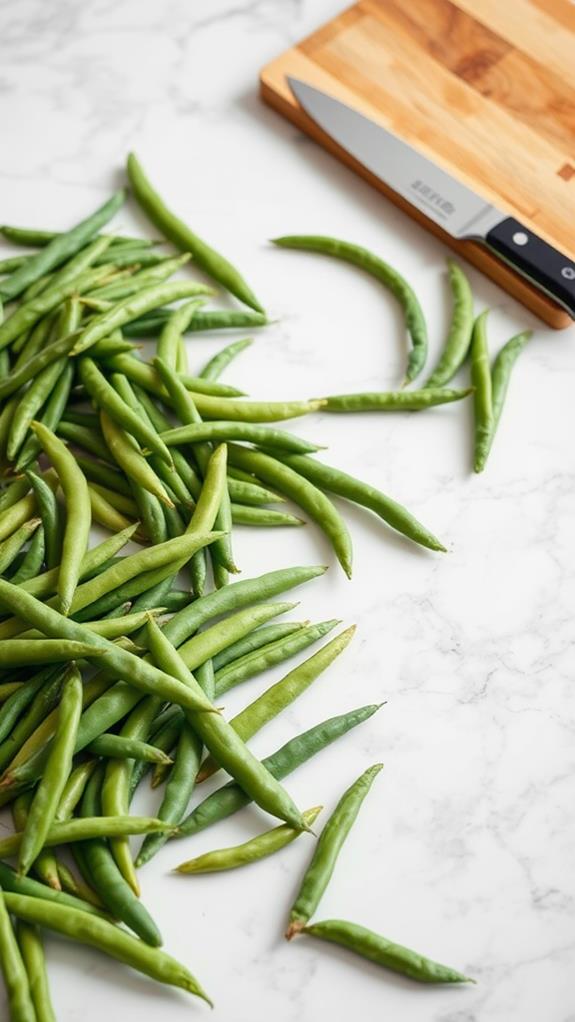
Raw green beans, also known as string beans or snap beans, are a popular vegetable often enjoyed in salads and as a crunchy snack. These vibrant green pods are actually the unripe fruit of various cultivars of the common bean. When you're considering eating raw green beans, it's important to understand their composition and potential effects on your body. Like Brussels sprouts, raw green beans contain complex carbohydrates and fiber that may cause digestive discomfort in some individuals, particularly those with sensitive stomachs.
Green beans contain complex carbohydrates, fiber, and various vitamins and minerals. They're particularly rich in vitamin C, vitamin K, and folate. However, they also contain lectins, which are proteins that can cause digestive discomfort in some people when consumed raw. The cooking process typically reduces lectin content, making cooked green beans easier to digest.
When selecting raw green beans, look for firm, smooth pods with a bright green color. Avoid those with blemishes or signs of decay. To prepare them for raw consumption, wash them thoroughly under running water to remove any dirt or potential contaminants. You can then snap off the ends and eat them whole, or slice them thinly for added texture in salads. Remember, while raw green beans are generally safe for most people, individual tolerances may vary.
Potential Risks and Concerns
While raw green beans are often considered safe, you should be aware of potential risks. Uncooked beans contain toxins that can cause digestive discomfort, though green beans typically have lower levels than other varieties. Similar to green tomatoes, raw green beans contain small amounts of potentially harmful compounds that decrease with cooking. Additionally, raw beans may irritate your digestive system and carry a higher risk of bacterial contamination if not properly washed or handled.
Toxins in Raw Beans
Lurking within raw beans are compounds that can pose potential health risks. The most significant concern is lectins, which are proteins that can cause digestive issues and even toxicity in high amounts. You'll find lectins in many plants, but they're particularly concentrated in raw beans.
When you consume raw or undercooked beans, you're exposing yourself to these potentially harmful substances. Phytohaemagglutinin, a specific lectin found in beans, can cause nausea, vomiting, and diarrhea. It's worth noting that green beans contain lower levels of lectins compared to other bean varieties, but they're not entirely free of these compounds.
Another toxin to be aware of is linamarin, which is present in lima beans. This compound can release small amounts of cyanide when consumed. While green beans don't contain linamarin, it's important to understand the broader context of bean toxicity.
To mitigate these risks, proper cooking is essential. Boiling beans thoroughly breaks down most of the lectins and other potentially harmful compounds. This process makes beans not only safer to eat but also more digestible and nutritious.
Digestive System Irritation
Your digestive system may not appreciate raw green beans as much as you might think. When you consume raw green beans, you're introducing fibrous plant material that can be challenging for your stomach and intestines to break down. This difficulty in digestion can lead to various uncomfortable symptoms, including bloating, gas, and abdominal discomfort.
The tough cellulose fibers in raw green beans can be particularly problematic. Your body lacks the enzymes necessary to fully break down cellulose, which means these fibers remain largely intact as they move through your digestive tract. This can cause irritation to your intestinal lining and potentially lead to cramping or diarrhea.
Additionally, raw green beans contain complex carbohydrates that aren't easily digestible in their uncooked state. These carbohydrates can ferment in your gut, producing excess gas and causing further discomfort. Some people may also experience a feeling of fullness or heaviness after eating raw green beans, as the undigested fibers can slow down the digestive process. While these effects aren't typically dangerous, they can be unpleasant and may interfere with your daily activities or overall well-being.
Bacterial Contamination Risks
A significant concern when consuming raw green beans is the risk of bacterial contamination. Raw vegetables can harbor harmful bacteria like E. coli, Salmonella, or Listeria, which may cause foodborne illnesses. These pathogens can be present due to improper handling, contaminated irrigation water, or unsanitary farming practices.
When you eat raw green beans, you're not subjecting them to the heat that would typically kill these microorganisms. This increases your risk of ingesting live bacteria that could lead to gastrointestinal issues, ranging from mild discomfort to severe infections. It's particularly important to take into account this risk if you're part of a vulnerable population, such as pregnant women, young children, the elderly, or those with compromised immune systems.
To minimize bacterial contamination risks, you should thoroughly wash your green beans under running water before consumption. However, washing alone may not eliminate all bacteria. For ideal safety, consider blanching or lightly cooking your green beans. This process can drastically reduce the bacterial load while still preserving much of the vegetable's nutritional value and crisp texture.
Nutritional Profile of Green Beans
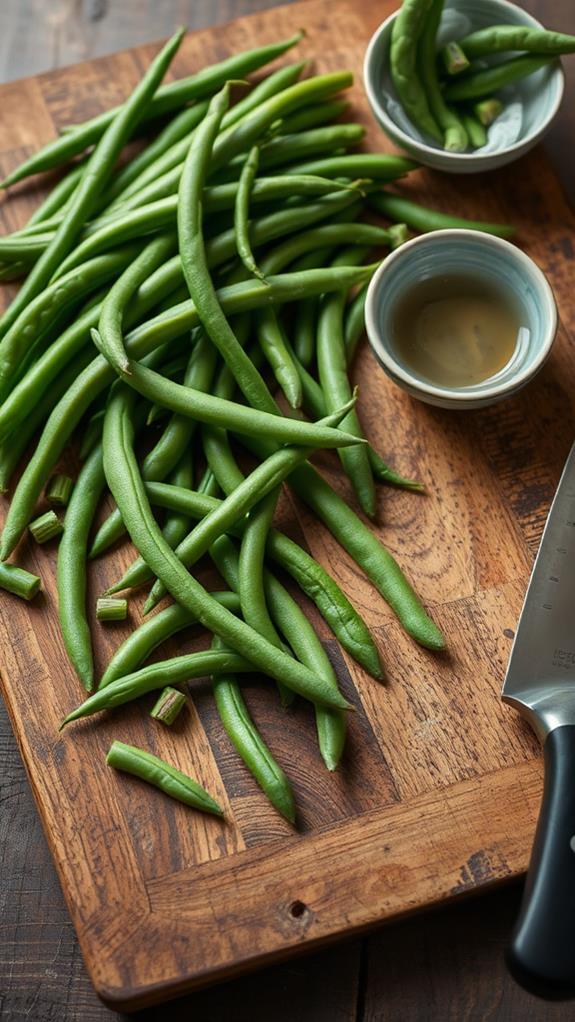
Green beans pack a nutritional punch despite their low calorie content. You'll find they're an excellent source of vitamins and minerals, making them a healthy addition to your diet. These legumes are particularly rich in vitamin C, vitamin K, and fiber.
Here's a breakdown of the nutritional content in a 100-gram serving of raw green beans:
| Nutrient | Amount | % Daily Value |
|---|---|---|
| Calories | 31 | – |
| Protein | 1.8g | 4% |
| Fiber | 2.7g | 11% |
| Vitamin C | 12.2mg | 14% |
| Vitamin K | 43μg | 54% |
As you can see, green beans are low in calories but high in essential nutrients. They're also a good source of antioxidants, which help protect your cells from damage. The fiber content aids in digestion and helps you feel full, potentially supporting weight management efforts. While raw green beans are safe to eat, cooking them slightly can increase the bioavailability of certain nutrients, making them easier for your body to absorb. Whether you choose to eat them raw or cooked, green beans are a nutritious vegetable to include in your meals.
Cooking Methods and Safety
When it comes to cooking green beans, you've got several safe and delicious options. Boiling, steaming, sautéing, and roasting are all popular methods that effectively eliminate any potential risks associated with raw beans. These cooking techniques not only confirm safety but also enhance the flavor and texture of your green beans. Similar to raw corn on the cob, green beans can be eaten raw, but cooking them is generally recommended for supreme safety and digestibility.
- Boiling: Submerge beans in salted water for 3-5 minutes until tender-crisp
- Steaming: Place beans in a steamer basket over boiling water for 5-7 minutes
- Sautéing: Cook beans in a hot pan with oil for 5-7 minutes, stirring frequently
- Roasting: Toss beans with oil and seasonings, then bake at 425°F for 10-15 minutes
While raw green beans are generally safe to eat, cooking them reduces the risk of foodborne illness and improves digestibility. It is critical to note that proper food handling and storage are pivotal for maintaining safety, regardless of cooking method. Always wash your green beans thoroughly before preparation, and store them in the refrigerator to maintain freshness. By following these guidelines, you'll confirm that your green beans are both safe and delicious.
Expert Opinions on Consumption
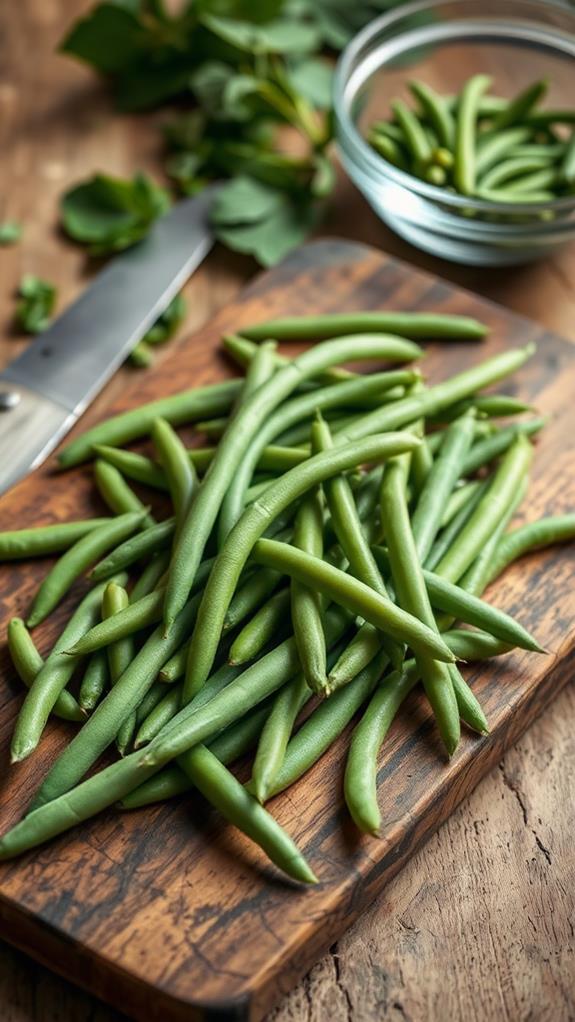
Nutritionists and food safety experts generally agree that eating raw green beans is safe for most people. However, they often recommend consuming them in moderation. While raw green beans contain beneficial nutrients, cooking can make some of these more bioavailable, meaning your body can absorb them more easily.
You'll find that experts often suggest blanching or lightly steaming green beans to maintain their nutritional value while reducing potential risks. This process helps to eliminate any surface bacteria and slightly softens the beans, making them easier to digest. Some specialists point out that raw green beans contain lectins, which are proteins that can cause digestive discomfort in some individuals. Cooking reduces lectin content.
It's worth noting that people with compromised immune systems, pregnant women, or those with sensitive digestive tracts might be advised to avoid raw green beans altogether. These groups are more susceptible to foodborne illnesses. If you're unsure about whether raw green beans are suitable for you, it's always best to consult with your healthcare provider or a registered dietitian for personalized advice tailored to your specific health needs and conditions.
Toxins in Raw Legumes
Raw green beans, like many legumes, contain a compound called phytohaemagglutinin, which can be toxic in high amounts. You'll be glad to know that cooking your green beans thoroughly reduces this toxin to safe levels, making them perfectly fine to eat. If you consume raw or undercooked beans with high levels of this compound, you might experience symptoms of bean poisoning, including nausea, vomiting, and diarrhea.
Phytohaemagglutinin in Green Beans
Many raw legumes, including green beans, contain a compound called phytohaemagglutinin. This protein can cause digestive issues when consumed in large quantities. While green beans have lower levels of phytohaemagglutinin compared to other legumes, it's still important to understand its potential effects.
When you consume raw green beans, you might experience:
- Nausea and vomiting
- Diarrhea and abdominal pain
- Bloating and gas
- In severe cases, dehydration
Cooking green beans thoroughly deactivates phytohaemagglutinin, making them safe to eat. The heat breaks down the protein's structure, rendering it harmless. However, if you're considering eating raw green beans, it's essential to weigh the risks. While a few raw beans are unlikely to cause significant problems, consuming large amounts could lead to discomfort.
For those interested in content creation and SEO, it's worth noting that discussing food safety topics like this can boost your website's E-A-T (Expertise, Authoritativeness, Trustworthiness) signals. By providing accurate, well-researched information on potentially harmful compounds in foods, you're demonstrating your commitment to user safety and establishing yourself as a reliable source in the culinary niche.
Cooking Reduces Toxicity
Cooking green beans and other legumes isn't just about enhancing flavor; it's a vital step in reducing potentially harmful compounds. When you cook legumes, you're substantially lowering the levels of phytohaemagglutinin and other toxins that can cause digestive issues. This process, known as denaturation, alters the proteins' structure, rendering them harmless.
Here's a breakdown of how cooking affects toxin levels in common legumes:
| Legume | Raw Toxin Level | Cooked Toxin Level | Cooking Method | Time to Safe Level |
|---|---|---|---|---|
| Green Beans | High | Low | Boiling | 10-15 minutes |
| Kidney Beans | Very High | Negligible | Boiling | 30 minutes |
| Lentils | Moderate | Very Low | Boiling | 15-20 minutes |
| Chickpeas | Low | Negligible | Boiling | 60 minutes |
| Soybeans | High | Low | Boiling | 2-3 hours |
You'll notice that boiling is the most effective method for toxin reduction. It is essential to follow proper cooking times to ascertain safety. While some legumes, like green beans, require less cooking time, others, such as kidney beans, need longer exposure to heat for complete toxin elimination.
Symptoms of Bean Poisoning
Despite the nutritional benefits of legumes, consuming them raw can lead to severe discomfort and illness. If you've eaten raw or undercooked beans, you might experience symptoms of bean poisoning within a few hours. These symptoms can range from mild to severe and may include:
- Nausea and vomiting
- Abdominal pain and cramping
- Diarrhea, which can be severe
- Fever and chills
The severity of your symptoms will depend on how many raw beans you've consumed and your individual sensitivity. In most cases, symptoms will resolve on their own within 24 to 48 hours. However, severe cases may require medical attention, especially if you're experiencing prolonged vomiting or diarrhea, which can lead to dehydration.
It's important to note that different types of beans contain varying levels of toxins. Red kidney beans, for example, have the highest concentration of lectins, the compounds responsible for bean poisoning. While green beans generally contain lower levels of these toxins, it's still advisable to cook them thoroughly to guarantee safety and improve digestibility.
Digestibility and Nutrient Absorption
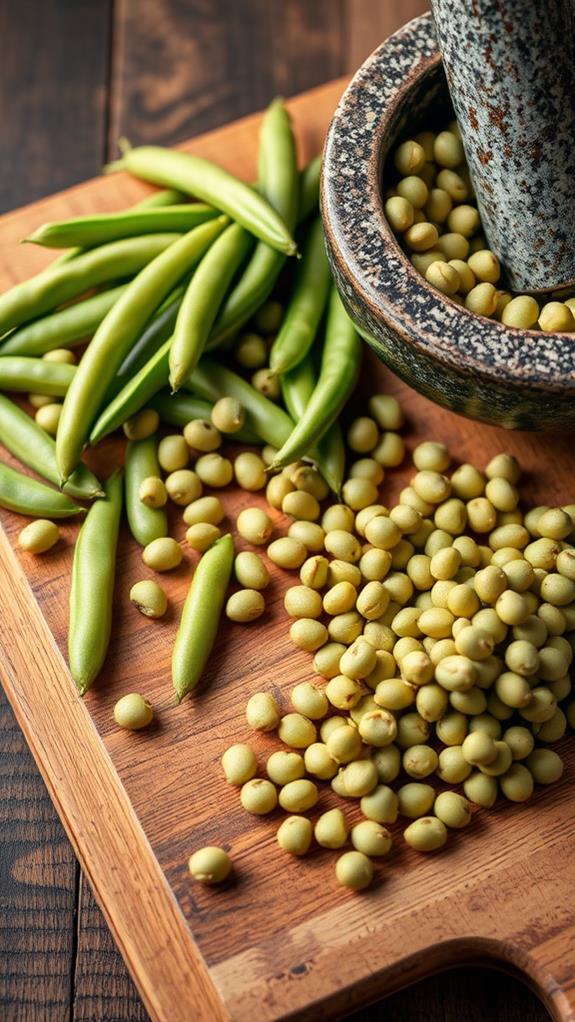
Raw green beans present challenges for your digestive system. When you eat them uncooked, you're consuming enzymes that can interfere with nutrient absorption. These enzymes, known as antinutrients, bind to minerals like iron, zinc, and calcium, making them less available for your body to use.
Moreover, raw green beans contain complex carbohydrates that are difficult for your digestive tract to break down. This can lead to bloating, gas, and discomfort. Cooking, on the other hand, helps to denature these antinutrients and soften the fiber, making nutrients more accessible and easier to digest.
While raw green beans do offer some nutritional benefits, such as vitamin C and folate, you'll likely absorb more nutrients from cooked beans. The heating process increases the bioavailability of certain compounds, like beta-carotene, which your body converts to vitamin A. Additionally, cooking can enhance the flavor profile and texture, making them more palatable.
If you're concerned about maximizing nutrient absorption from your green beans, consider lightly steaming or blanching them. This method preserves most of the nutrients while improving digestibility and reducing potential digestive discomfort.
Alternatives to Raw Consumption
If you're looking for alternatives to eating raw green beans, consider lightly steaming them. This cooking method preserves most of the nutrients while softening the beans and making them easier to digest. Another option is to sauté your green beans, which adds flavor and creates a more enjoyable texture while still maintaining many of the vegetable's health benefits.
Lightly Steaming Green Beans
Lightly steaming green beans is one of the best alternatives to eating them raw. This cooking method preserves most of the nutrients while making the beans easier to digest and safer to consume. When you steam green beans, you're reducing the risk of foodborne illness associated with raw vegetables while maintaining their crisp texture and vibrant color.
To lightly steam green beans:
- Rinse the beans thoroughly under cool water
- Trim the ends and remove any strings
- Place them in a steamer basket over boiling water
- Steam for 3-5 minutes until bright green and tender-crisp
Steaming helps to break down some of the lectins, which are potentially harmful proteins found in raw beans. It also softens the cellulose in the bean's cell walls, making them more digestible. You'll find that lightly steamed green beans retain much of their nutritional value, including vitamins A, C, and K, as well as fiber and antioxidants. This method strikes a balance between food safety and nutritional benefit, offering you a delicious and healthy way to enjoy green beans.
Sautéing for Added Flavor
Another tasty alternative to raw green beans is sautéing. This cooking method involves quickly frying the beans in a small amount of oil or butter over high heat. You'll want to start with fresh, crisp green beans that you've washed and trimmed. Heat your pan, add a tablespoon of oil, and toss in the beans once the oil is hot.
Sautéing typically takes about 5-7 minutes, depending on your preferred level of tenderness. You'll want to stir or toss the beans regularly to ascertain even cooking. This method allows you to add extra flavor to your green beans. You can experiment with garlic, shallots, or herbs for added depth. A splash of lemon juice at the end can brighten the dish.
The high heat of sautéing helps to preserve the beans' nutrients while enhancing their flavor through caramelization. This process creates a Maillard reaction, which is a chemical interaction between amino acids and sugars that produces complex flavors and aromas. The result is a dish with a tender-crisp texture and a rich, savory taste that's far more complex than raw green beans.
Myths vs. Facts
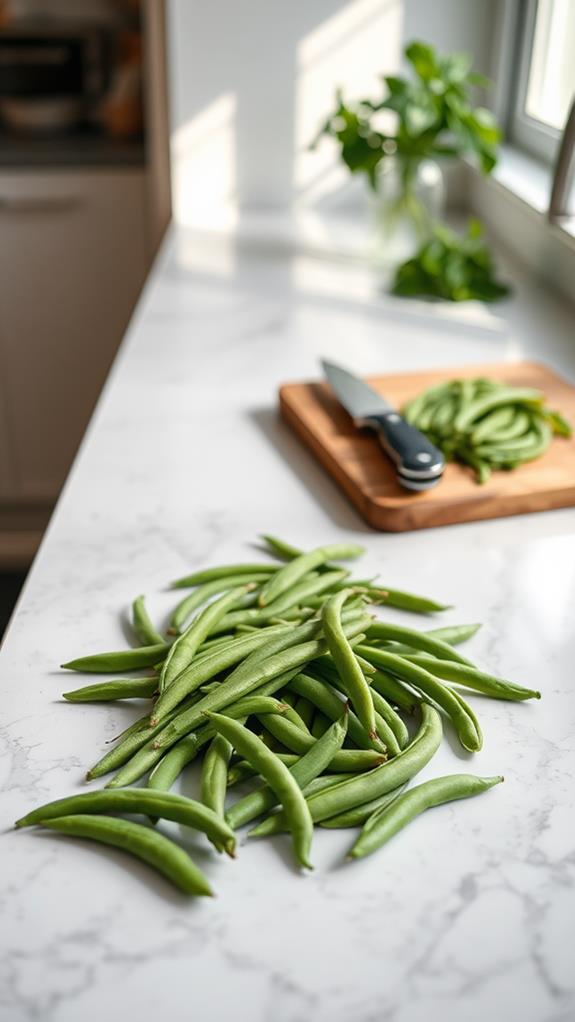
Surrounded by misconceptions, the safety of eating raw green beans has been a topic of debate among food enthusiasts and health-conscious individuals alike. Let's debunk some myths and uncover the facts about consuming these crisp, green veggies in their raw state.
- Myth: Raw green beans are toxic
- Fact: They contain small amounts of lectins
- Myth: Cooking is always necessary
- Fact: Moderate raw consumption is generally safe
You've probably heard that raw green beans are dangerous to eat, but this isn't entirely true. While they do contain lectins, which are proteins that can cause digestive issues in large quantities, the amount in green beans is relatively low. You'd need to eat an excessive amount to experience any negative effects.
It's important to note that cooking does reduce lectin content, making green beans easier to digest. However, occasional raw consumption in moderation is generally safe for most people. If you have a sensitive stomach or existing digestive issues, you might want to stick to cooked green beans. Always wash your produce thoroughly before eating to remove any potential contaminants. Remember, individual tolerances can vary, so listen to your body when trying new foods.
Making an Informed Decision
When deciding whether to eat raw green beans, it's crucial to weigh the potential benefits against the risks. Consider your personal health status, including any underlying conditions or compromised immune system. If you're pregnant or have digestive issues, you might want to err on the side of caution and cook your green beans.
Evaluate the source of your green beans. If they're from your garden or a trusted local farmer, you'll have better insight into their growing conditions and handling. Store-bought beans may have been exposed to more potential contaminants during processing and transportation. Always wash your green beans thoroughly, regardless of their source.
Consider the nutritional trade-offs. While raw green beans retain more vitamins, cooking can increase the bioavailability of certain nutrients. If you decide to eat them raw, start with small amounts to see how your body reacts. Be aware of symptoms like nausea or digestive discomfort, which could indicate lectin sensitivity.
Ultimately, the decision is yours. By understanding the facts and examining your personal circumstances, you can make an informed choice about including raw green beans in your diet.
Frequently Asked Questions
Can Pregnant Women Eat Raw Green Beans?
If you're pregnant, it's best to avoid eating raw green beans. While they're generally safe for most people, raw beans can harbor bacteria like Listeria, which poses a higher risk during pregnancy. You should cook green beans thoroughly to eliminate potential pathogens. Steaming, boiling, or sautéing them until tender guarantees they're safe to consume. Remember, proper food safety is essential during pregnancy to protect both you and your baby. Always consult your healthcare provider for personalized dietary advice.
How Long Can Raw Green Beans Be Stored in the Refrigerator?
You'll want to handle your green legumes with care. Raw green beans can be stored in the refrigerator for about 5-7 days. To maximize freshness, place them in a plastic bag or airtight container before refrigerating. Don't wash them until you're ready to use them, as excess moisture can promote mold growth. If you notice any signs of spoilage, such as slimy texture or off-odors, it's best to discard them. For longer storage, consider blanching and freezing your green beans.
Are There Specific Varieties of Green Beans Safer to Eat Raw?
You'll find that most common green bean varieties are safe to eat raw. However, some types, like snap beans and string beans, are particularly tender and well-suited for raw consumption. It's crucial to recognize that while all green beans are technically edible raw, some varieties might be tougher or have a more fibrous texture. Always wash your beans thoroughly before eating, and if you have any concerns about a specific variety, it's advisable to cook them to guarantee safety and digestibility.
Can Dogs or Cats Safely Consume Raw Green Beans?
As green as the grass on the other side, raw green beans are generally safe for dogs and cats to consume. You can offer them as a low-calorie treat or snack. They're packed with vitamins and fiber, which can be beneficial for your pets' health. However, you shouldn't overdo it. Too many raw green beans may cause digestive issues. It's always best to introduce new foods gradually and in moderation. If you're unsure, consult your veterinarian for personalized advice.
Do Organic Green Beans Have Fewer Risks When Eaten Raw?
Organic green beans don't necessarily have fewer risks when eaten raw. While they're grown without synthetic pesticides, they can still harbor bacteria from soil or handling. You'll want to wash them thoroughly before consuming. The primary concern with raw green beans isn't pesticides but naturally occurring compounds that can cause digestive discomfort. Cooking breaks down these compounds, making them easier to digest. If you prefer raw beans, organic or conventional, it's best to eat them in moderation.
Conclusion
You've made it through the great green bean debate, and you're still standing. Congratulations! While raw green beans won't likely send you to the emergency room, they're not exactly a gourmet delicacy either. You're better off cooking them, unless you enjoy the thrill of potential lectin-induced stomach discomfort. Remember, sometimes the path of least resistance (and digestion) is the wisest choice. So, go ahead and give those beans a quick sauté – your taste buds and intestines will thank you.





